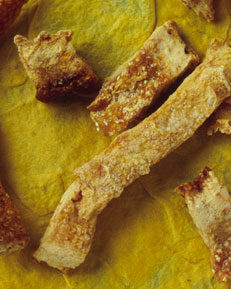 |
Bitter Orange, Neroli, Petitgrain
Citrus x aurantium subsp. amara
Family: Rutaceae
CTFA Name: Citrus Aurantium Amara |
Return to herb list |

Photo © Steven Foster
Introduction
Bitter orange is an evergreen tree that grows to 33 feet with dark green, glossy leaves, fragrant white flowers, and orange fruit.1 Although native to the Far East (mainly India and China), the tree grows well in the Mediterranean, US, Israel, and South America. The main producers of bitter orange raw materials are Spain, Guinea, the West Indies, Italy, Brazil, and the U.S. Bitter orange oil comes from the fruit and is dark yellow with a fresh, floral fragrance and sweet undertones. Neroli oil comes from the flower blossoms and is pale yellow to orange with a sweet, floral smell. It is produced mainly in France, but also in Egypt, Morocco, Italy, and Tunisia. Petitgrain oil is produced from the leaves and stems and is pale yellow to amber in color with a floral-citrus scent. The best petitgrain oil comes from France, but it is also produced in Paraguay, Haiti, and North Africa.1 History and Cultural Significance
In China, two medicinal preparations are made from bitter orange, zhi quiao from the dried peel of immature green fruit and zhi shi from dried fruit. They are added to formulas for the treatment of mild indigestion, nausea, and constipation.2 Bitter orange oil is used in aromatherapy to calm nervousness.3 Neroli oil is named after a 17th century princess of Nerola in Italy who wore gloves perfumed with the oil.4 Orange flowers have been used in bridal bouquets and hair wreaths to calm wedding day nerves.1 Also known as orange blossom, the oil has been used to soothe anxiety. The oil of neroli can often be found in expensive perfumes. The Romans were said to have used orange flower water to prevent hangovers after their orgies.1 Petitgrain is used to clean oily skin and hair and remove perspiration.1 It is employed extensively in the cosmetics industry in colognes and soaps, as well as in detergents, confectionary foods, alcohol, and soft drinks.1 Modern Research
In a 2000 study, orange oil diffused into a dentist's waiting room was shown to decrease the level of anxiety, create a more positive mood, and increase calmness in women who were exposed to the orange scent.5 Future Outlook
Very little information is available on the production, commercial cultivation, and future of C. aurantium subsp. amara. Due to the limited supply source, neroli oil is one of the most expensive essential oils on the market.6 A full-grown bitter orange tree will produce for 20 years, and usually produces approximately 60 pounds of fresh flowers from which neroli oil can be distilled.8 References
1 Lawless J. The Illustrated Encyclopedia of Essential Oils: The Complete Guide to the Use of Oils in Aromatherapy and Herbalism. Rockport, MA: Element Books, Inc.; 1995. 2 Huang KC. The Pharmacology of Chinese Herbs. Boca Raton, FL: CRC Press; 1993. 3 Schnaubelt K. Advanced Aromatherapy: the Science of Essential Oil Therapy. Rochester, VT: Healing Arts Press; 1998. 4 Hocking GM. A Dictionary of Natural Products. Medford, NJ: Plexus Publishing, Inc.; 1997. 5 Lehrner J, Eckersberger C, Walla P, Potsch G, Deecke L. Ambient odor of orange in a dental office reduces anxiety and improves mood in female patients. Physiol Behav. Oct 1-15, 2000;71(1-2)83-86. 6 Davis E, Hassler J, Ho P, Hover A, Kruger W. Esential oils. Available at: http://www.wsu.edu/~gmhyde/433_web_pages/433Oil-web-pages/essence/essence-oils.html. Accessed March 22, 2005.
|